Images of Gettysburg are never far away once you had visited there. Like ghosts jumping at you from the dark, they keep coming before the mind’s eye, sometimes at unexpected moments.
It happened to me recently when I watched US presidential contender Donald Trump on television making a speech there, which was said to be the start of the wrap-up of his campaign. The choice of venue struck me as somewhat ironic considering the deep gashes the extraordinary bitter electioneering of these past many months seem to have inflicted on the American psyche.
There is of course a certain sense in using Gettysburg as a political rallying point. It is after all where Abraham Lincoln, in what is regarded as one of the greatest speeches of all time, uttered those immortal words about government of the people, by the people, for the people …
But Gettysburg also stands out as one of the bloodiest battlefields of the American Civil War. That, and the almost eerie serenity of what is now one of the most visited historic sites in America should make it a place for deep reflection rather than inspiring discord.
I found myself drifting into just such a contemplative mood from the moment I set foot there. Every part of the terrain had its own effect.
The weirdest feeling, almost of a godlike quality, came over me as I walked around its Cyclorama. Exploding cannon shells flashed across the battlefield around me, smoke rose, guns roared, men shouted and horses screamed. Yet, there I was, untouched by the death-dealing. It was as if I was looking from a drifting cloud, unseen by the combatants, at the terrible cruelties they were inflicting on each other.
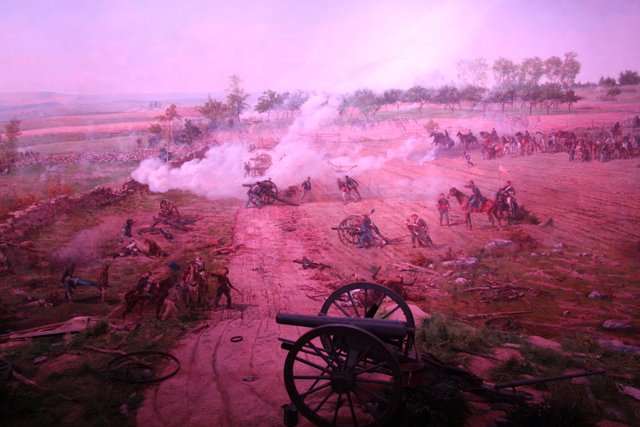
Yankee soldiers fend off the Dixie charge from behind a stone wall in one of the Gettysburg Cyclorama scenes.
I need not have felt embarrassed about my susceptibility. The cyclorama was the early version of the IMAX theatre, and it is said that veterans of the battle that took place in and around the little Pennsylvanian town over the first three days of July 1863 wept when, years later, they saw it depicted in the encircling picture. And that was without the light, sound and three-dimensional effects of modern technology.
Gettysburg is where the union forces under Major General George G. Meade set out to block the confederates’ victorious northward march to inflict more morale-sapping and perhaps decisive blows to the north. General Robert E. Lee threw the full force of his Dixie army at the Yankees, and had he apparently known how weak the defenses were at particular spots at certain times and pushed forward, the outcome and the country’s destiny may well have been different. It is unlikely Barack Obama would then have become president one day.
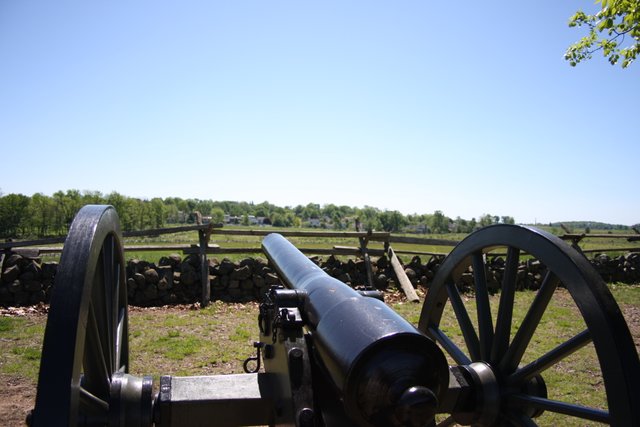
A canon guards silently over the battlefield.
As it was, the union defenses held. The scene depicted by the cyclorama is the so-called Pickett-Pettigrew assault, named so after the commanders, which on the third day came close to breaking through the Union lines. But it was repelled, and when the three-day battle was over, 51 000 men lay dead. The air had been so filled with flying lead that the Gettysburg museum has two bullets that collided and fused in mid-air. When Lee withdrew his army on the fourth day, the train of wounded behind him stretched for more than twenty kilometres.
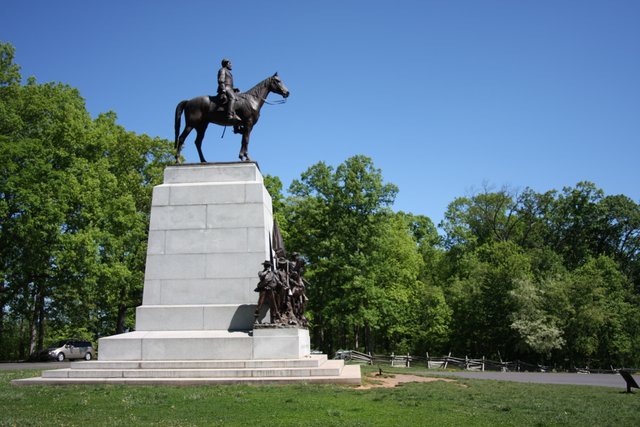
General Robert E. Lee stares across the battlefield where his confederates got driven back.
More than three million people visit the site every year. To me it was evident from the intensity with which a school group listened to their teacher and guide explaining the war and the details of the battle how important a place Gettysburg held in American history. It is where visitors from abroad, often baffled by the United States’ curiously state-divided politics, also tend to get some of the most telling insights into the American soul.
I remember how years ago when I first visited America, on the US government’s foreign visitors programme, I asked people to explain what exactly that terrible war was about. They answered by talking about confederate and less autonomous union rights, and vaguely about pro- and anti-slavery. I was intrigued some years later to read an article in Time magazine explaining that slaves were the biggest commercial commodity in America at the time, and therefore that slavery after all was the decisive issue.
It came to mind that in answer to my questions at the time, somebody handed me a tattered soft-cover book that had Gettysburg in its title. In it was the celebrated two-minute speech by President Abraham Lincoln in which, at a ceremony at the site about four months after the battle, he talked about the principles of human equality and of the civil war as a struggle not merely for the Union, but as a new birth of freedom that would bring true equality to all of its citizens.
It was with thoughts in mind about these painful issues and the ferocity with which compatriots, in many cases parents against children and siblings against each other, settled them that I went to Gettysburg.
I started with a slow stroll around the visitors centre’s museum which, with exhibits and interactive programmes, takes you through the causes of the war, the local battle and the personalities involved. I then entered a theatre to see a film entitled A New Birth of Freedom narrated in the resonant voice of actor Morgan Freeman before taking the escalator to the cyclorama where the lights dimmed and from a platform in the middle I saw the battle ensue.
The dramatic presentation is based on 1884 paintings by French artist Paul Dominique Philippoteaux, who was commissioned by a group of Chicago investors in 1879 to create the Gettysburg Cyclorama. Working with a team of twenty artists, he spent considerable time at the battle site to sketch and photograph the scene, and extensively research the bloody event.
After many travels and considerable damage, and even being forgotten about for a while, the painting was extensively restored and installed in the new Gettysburg Visitors Centre in 2008. It comes to 8.2 metres in height and a circumference of 109 metres. It has a three-dimensional diorama foreground and a sky that blends into an overhead canopy, all of which enhances the illusion of standing in the middle of the battlefield.
After the cyclorama, visitors go by bus or car on a tour of the battlefield, which spans a low valley with features named the Peach Orchard, Wheatfield, Devil’s Den and the Round Tops underscoring the homeliness of the county landscape until the day the opposing armies arrived. The curio shops, eateries and hostelries lining the town’s streets are testimony to how its fate was forever changed all that time ago when, it is said, holes had to be drilled into the church’s floor for the blood to drain as more and more wounded combatants were brought in.
The tour along a dirt road leading round the battlefield takes visitors to one after the other monuments erected along the fringe in honour of the men from the respective states who joined in the encounter. Some are dramatic, like Louisiana’s which depicts an angelic figure with a trumpet rising above the form of a dead soldier. Others are brutal, like Mississippi’s which shows a soldier with his foot on a fallen one’s torso and preparing to smash his skull with the but of his raised rifle. Others are just granite slabs with the name of the state, the men and a message etched in. They, too, by their very simplicity bring home the tragedy.
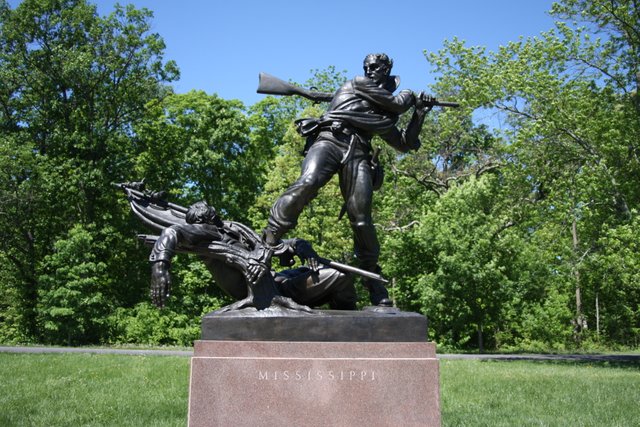
The Mississippi memorial depicting the brutality of the Gettysburg battle.
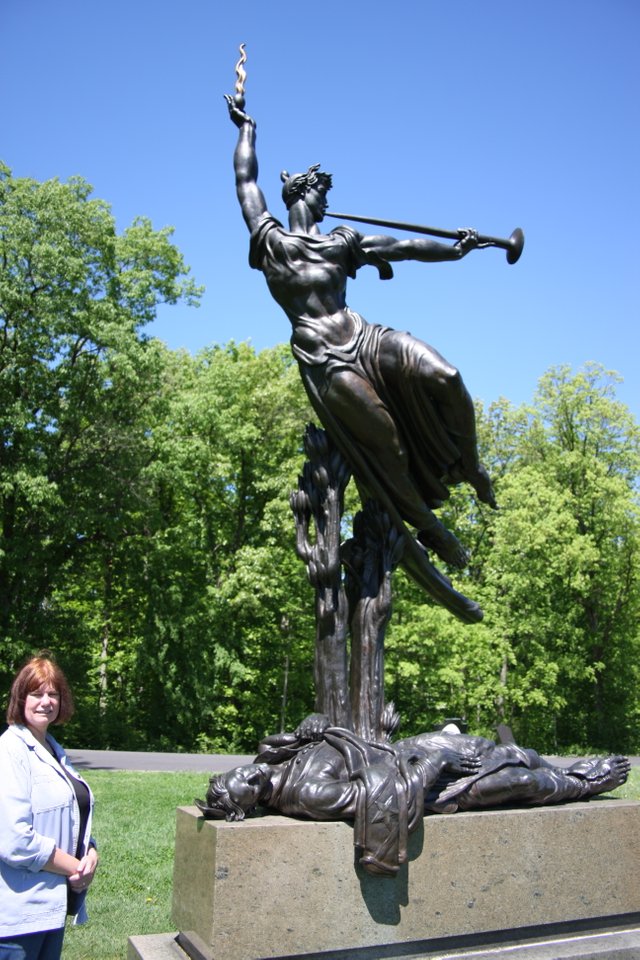
The dramatic Louisiana memorial.
There is an imposing statue of General Lee on his horse, staring out over the battlefield. At the far end, at the rocky outcrop from which the Union army repelled the assaults, there is a statue of General Meade standing on a rock and also staring out across the landscape that now looks so blissfully peaceful.
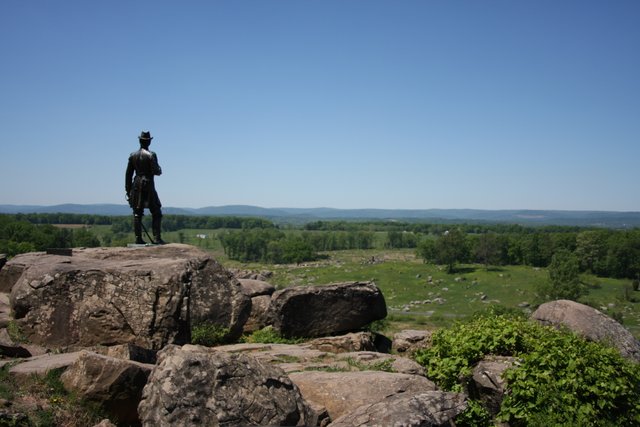
A statue of Major General George G. Meade on the rocks where his Union soldiers made their stand.
It is hardly surprising that Gettysburg is in many writings about it said to be a favourite haunt of those who dwell in the paranormal. There are many tales of strange sightings, of ghosts and disembodied screams, and whatever the fantasies are of the kind. It is even claimed that there tends to be a flurry of paranormal activity during the summer months when more visitors from the South turn up.
What struck me when I visited was how quiet, almost respectful, the throngs of people and pupils were who passed through the visitors centre, who stopped at the various monuments along the battlefield route to read the inscriptions, and who trooped along the footpath winding among the rocks where the Union soldiers were ensconced.
It is indeed a deeply touching place.
(All are my own words and pictures.)
Downvoting a post can decrease pending rewards and make it less visible. Common reasons:
Submit
Well written. I like the photos since this is the first time I see the actual Gettysburg site (In Europe we are more focused on local wars while learning history.)
This reminds me of a strange movie I saw, Abraham Lincoln: Vampire Hunter. I highly recommend it to all fantasy lovers. A great alternative interpretation of American history, Gettysburg included. IMDB
Downvoting a post can decrease pending rewards and make it less visible. Common reasons:
Submit
Thank you. Gettysburg really does have a key place in American history.
Downvoting a post can decrease pending rewards and make it less visible. Common reasons:
Submit